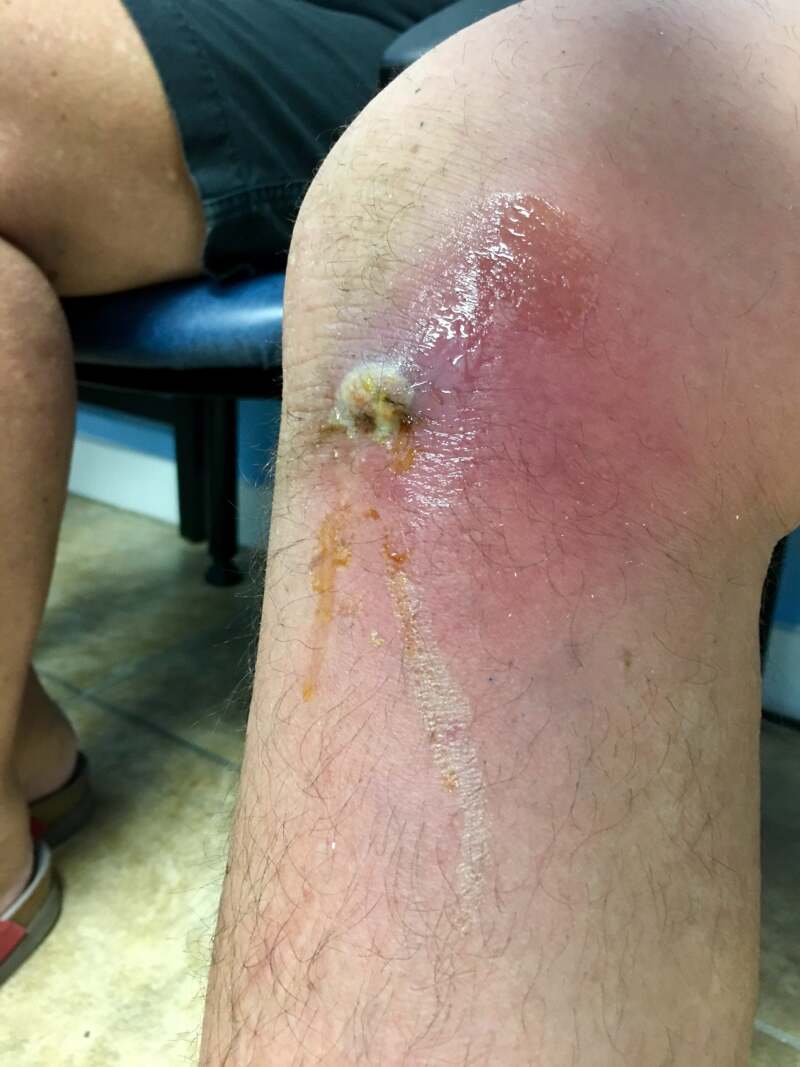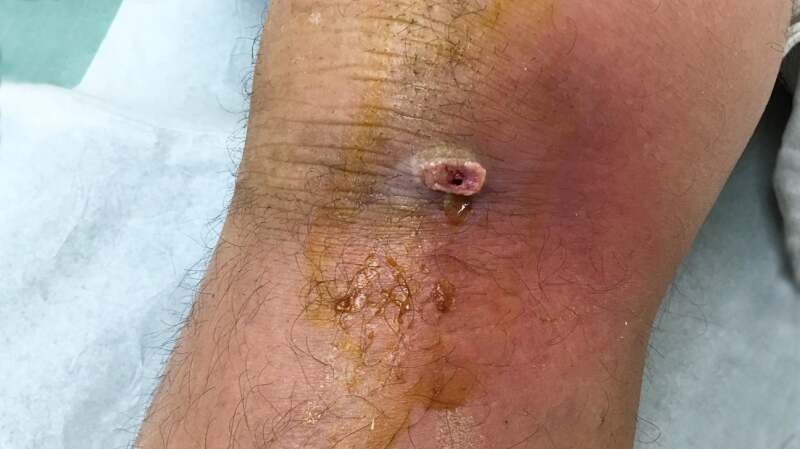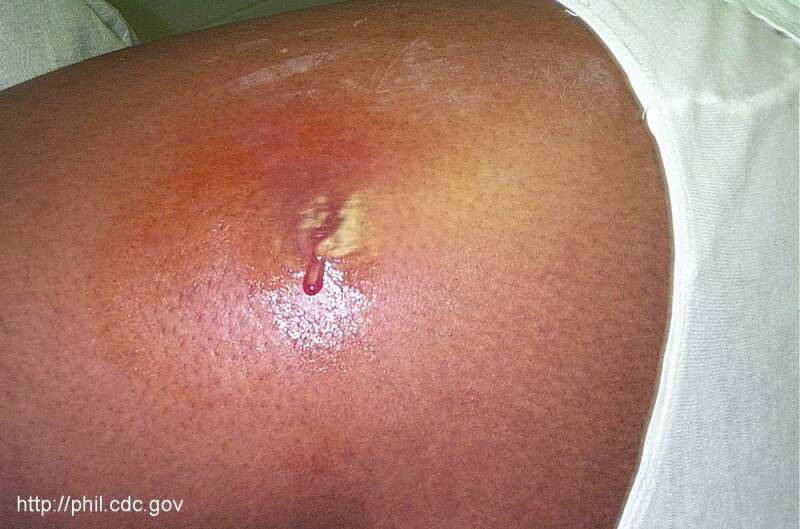This article will explain more about MRSA and its symptoms, causes, treatment, and prevention tips.
What are the different types of MRSA?

Healthcare-associated or hospital-acquired MRSA (HA-MRSA) and community-acquired MRSA (CA-MRSA) are the
HA-MRSA
CA-MRSA spreads mainly through skin-to-skin contact with someone who has an infection from the bacteria. Contaminated items can also spread the bacteria.
For CA-MRSA, doctors may drain an abscess or boil and may or may not need to prescribe antibiotics. For more serious infections and HA-MRSA, certain antibiotics are still effective against MRSA.
Complications from CA-MRSA can happen quickly. Get prompt medical care for symptoms of a skin infection, such as warm, swollen or tender skin.
Also get immediate medical care if fever, confusion, or shortness of breath accompany the above symptoms. Never try to drain a skin abscess or blister yourself, as this can lead to serious complications.
Learn about hospital infections here.
What are the symptoms of MRSA?
CA-MRSA infection often develops near a cut, wound, or open sore. But it can also start on intact skin.
Common symptoms
Initially, CA-MRSA infection may look like a minor skin problem, with bumps, pimples, or lesions resembling bug bites. Other
- painful or tender
- pus-filled or draining pus or other fluid
- discolored
- swollen
- warm to the touch
Serious symptoms that might indicate a life threatening condition
In some cases, CA-MRSA can become a serious and even life threatening infection. Get immediate medical care by calling 911 if you, or someone you are with, have skin infection symptoms or any of the following symptoms:
- confusion or disorientation
- fever or chills
- general feeling of malaise or sickness
- rapid heart rate
- shortness of breath
- sweaty or clammy skin
Contacting your doctor at the first symptom of a skin infection can help prevent the infection from becoming serious.
Learn about the warning signs of MRSA here.
What causes MRSA?
MRSA results from many years of incorrect antibiotic use. Antibiotics work by targeting the replication processes of bacteria. Resistance develops when bacteria can adjust these processes to get around the antibiotic. Bacteria can make these changes quickly and learn with each new antibiotic exposure.
Some people can use antibiotics incorrectly when taking them for viral infections, such as a cold or flu. Antibiotics can only treat bacterial infections. However, even with legitimate bacterial infections, people can still use them incorrectly. For example, they do not finish the entire course of antibiotics their doctor prescribes.
In each of these cases, bacteria get exposure to the antibiotic and an opportunity to learn how to grow even in the presence of the drug. Some bacteria survive and pass on the information they gain from the exposure as they replicate.
Learn about different types of staph infections here.
What are the risk factors for MRSA?
A number of factors increase the risk of developing MRSA. However, risk factors for HA-MRSA and CA-MRSA are different.
The following factors might increase the chance of exposure to HA-MRSA,
- staying in a hospital, long-term care home, or other healthcare facility, especially for older adults, people with weakened immune systems, and people with chronic medical conditions
- having surgery or another invasive procedure
- getting medical device or tubing placement, such as IV lines, central lines, and urinary catheters
Factors that might increase the chance of exposure to CA-MRSA,
- having male-to-male sex without a condom or another barrier method
- staying in crowded or unhygienic conditions, such as in camps, dorms, jails, and military barracks
- participating in contact sports, such as wrestling and football
- sharing personal items, such as towels and sports equipment
- taking IV drugs
- working in child care settings
- living with people with MRSA
As an easy way to remember the risk factors, the
- crowding
- contact
- compromised skin
- contaminated items
- lack of cleanliness
How can I prevent MRSA infection?
Hygiene plays a large role in both HA-MRSA and CA-MRSA. Inadequate handwashing can contribute to the spread of MRSA in facilities. So, adequate handwashing is essential for preventing MRSA. When you have HA-MRSA, isolate yourself and follow infection control procedures can help prevent the spread.
You may be able to lower your risk of CA-MRSA
- cleaning cuts, wounds, scrapes, and open sores daily and covering them with clean, dry bandages
- protecting your skin with a towel or clothing to prevent contact and cleaning shared sports equipment before use
- avoiding sharing personal items, including towels, razors, uniforms, or clothing that touches the skin
- showering right after games or practices
- laundering athletic clothing and uniforms after every use
- washing your hands regularly while you sing the Happy Birthday song twice to measure the correct time
If you have a high risk of getting an infection from CA-MRSA, talk with your doctor about ways to prevent it. Make sure you know the warning signs and contact your doctor right away about any concerns.
How is MRSA treated?
To find out if MRSA is the cause of an infection, your doctor
For HA-MRSA, there are
For CA-MRSA, treatment may or may not involve antibiotics. Often, doctors can drain the infection from an abscess. Keeping the wound clean and applying ointment as directed may be all that is necessary. Sometimes, doctors also need to prescribe oral antibiotics. Be sure to finish the entire course and ask what to do if you miss a dose.
Contact your doctor if the infection does not improve or your symptoms get worse.
Learn about overcoming serious staph infections here.
What are the potential complications of MRSA?
CA-MRSA can lead to serious and life threatening complications. This includes infections of the bones, blood, heart, lungs, joints, or other organs.
People with weakened immune systems and older adults may have a
However, complications from CA-MRSA can be uncommon in generally healthy people who receive prompt and adequate treatment.
Other frequently asked questions
The following are some commonly asked questions about MRSA.
Is MRSA usually fatal?
Whether MRSA can lead to death
Some cases of MRSA do resolve on their own. You can work with a healthcare professional to reduce your risk of complications from the infection.
How long is MRSA contagious?
MRSA is usually contagious for 4–10 days. However, this can vary.
Can you get MRSA from a toilet seat?
You can get MRSA from a toilet seat. MRSA can survive on some surfaces, including towels, furniture, and other equipment, for
What is the fastest way to get rid of MRSA?
Powerful antibiotics, such as vancomycin or daptomycin, can help treat MRSA. However, you may need to take an alternative course of treatment depending on your circumstances.
Summary
MRSA stands for methicillin-resistant Staphylococcus aureus bacteria. You can also call the bacteria Staph aureus or staph for short. MRSA can be more challenging to treat than regular staph infections because it is resistant to certain antibiotics.
MRSA is usually treatable, but timely treatment is crucial because complications can develop. Certain populations, such as older adults or people with weakened immune systems, may be more at risk for complications of staph infections.








